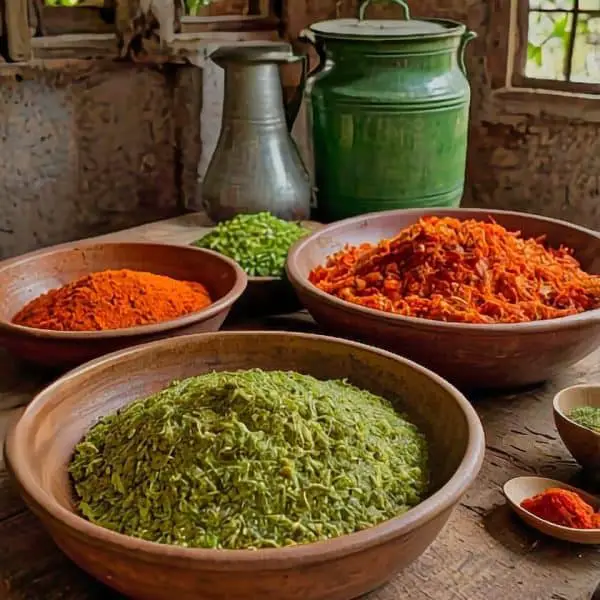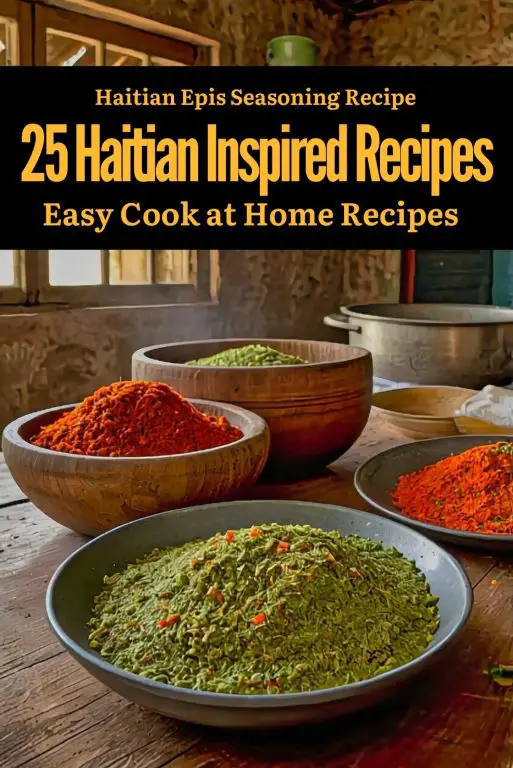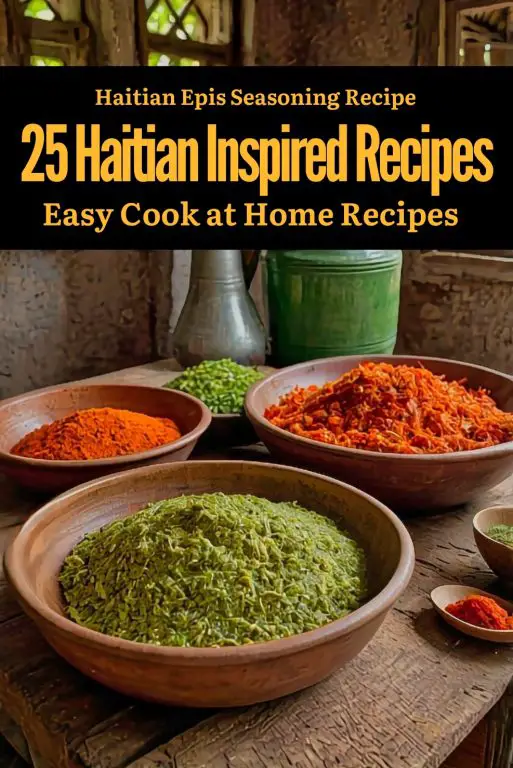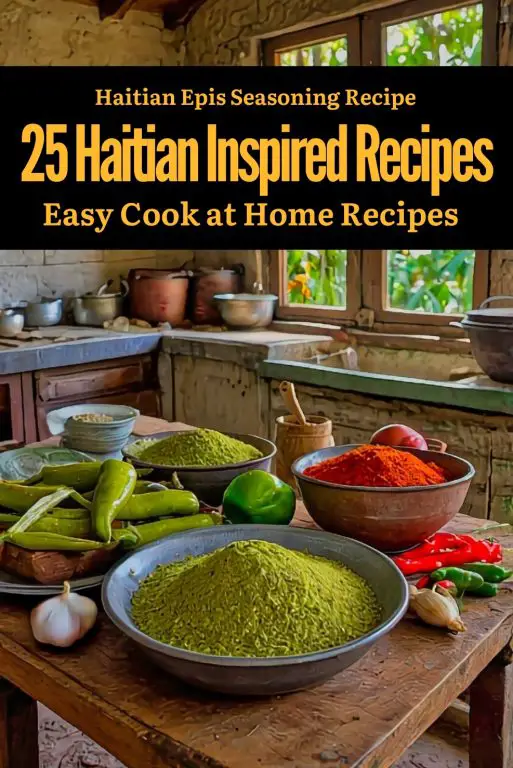Haitian Epis seasoning recipe is one of my favorite parts of Haitian cooking I discovered during a food tour in Haiti. It is used in many Haitian dishes as a seasoning. Our group visited several local markets to see how Haitian Epis seasoning recipe is made and to see how fresh ingredients are used in Haitian cooking.
Herbal plants and veggies in Haitian Epis seasoning consist of parsley, cilantro, green and red bell peppers, onions, scallions and garlic. It also uses fresh thyme and oregano leaves. The freshness of these ingredients is key to how good the epis seasoning is. Fresh herbs and vegetables make the seasoning smell and taste better in any dish they are used in.
We learned on our tour that to make a good Haitian Epis Seasoning Recipe you need to use freshly picked ingredients. This means the herbs should smell like the soil and the vegetables should be hard and bright. Fresh ingredients make food taste better because they have more natural oils and flavors.
We met a local cook and learned how to make the Haitian Epis Seasoning Recipe. She said fresh lime juice and olive oil are key in the mixture. These liquids keep the herbs green and lend a tangy flavor to the seasoning. A little white vinegar in can keep the epis fresher for longer without altering the flavor, she told us.
While we watched her mix everything, we could tell that each part was very fresh and it turned green and smelled so good. The chef let us taste a bit of the epis on some grilled chicken and we could tell the difference. The new herbs and spices made the chicken taste so much better.
It was not just about watching and tasting the Haitian Epis seasoning recipe. It was about understanding just how important fresh, good ingredients are to Haitian cooking. This simple seasoning is full of flavors that make food exciting. It was a fun and informative segment of our food tour and showed just how simple a seasoning mix can be.
Ingredients For the Haitian Epis Seasoning Recipe
Parsley Stems Removed
Cilantro Stems Removed
Chopped Green Bell Pepper
Chopped Red Bell Pepper
Chopped Onion
Peeled Garlic Cloves
Chopped Scallions
Fresh Rhyme Leaves
Fresh Oregano Leaves
Salt
Black Pepper
Olive Oil
White Vinegar
Lime Juice
Cooking Instructions For the Haitian Epis Seasoning Recipe
- Wash and dry the parsley and cilantro, then remove the stems.
- Roughly chop the parsley, cilantro, green and red bell peppers, onion, garlic, and scallions. Place all the chopped ingredients in a food processor or blender. Add the fresh thyme leaves, oregano leaves, salt, black pepper, olive oil, white vinegar, and lime juice.
- Pulse or blend until all the ingredients are well combined and the mixture is smooth.
- Taste and adjust seasoning as needed.
- Store the Epis seasoning in an airtight container in the refrigerator for up to 2 weeks.
Foods Most Eaten by Haitian Locals
Haitian cuisine reflects African, French, Taino, and Spanish culinary traditions. Another staple food in Haitian households is “diri ak pwa,” or rice and beans, consisting of black, red or white beans with spices and typically meat or fish. Griot (marinated and fried pork) is a popular dish served with “banan peze,” fried plantains, and pikliz (spicy pickled vegetable slaw). This is a popular combination at gatherings and celebrations.
Another popular dish is legim, a stew of vegetables that combines spinach with chayote, eggplant along with other vegetables and is usually cooked with meat or seafood and served with rice. A comforting meal on weekends is “bouillon,” a thick soup with beef, plantains, yams and other vegetables. For breakfast, “akasan,” a warm cornmeal porridge with milk and cinnamon, is a popular breakfast option.
Street food is also a staple in Haitian cuisine, with vendors selling various snacks. Pate is a flaky pastry filled with meat, fish or vegetables that is usually eaten on the go, and fritay is a platter of fried foods that include plantains, malanga, and sometimes seafood. Soup joumou, a pumpkin soup eaten on New Year’s Day to celebrate Haitian independence, is symbolic and popular. Together these dishes reflect the diversity and richness of Haitian food culture that reflects its people’s resilience and creativity.
5 Essiential Ingredients for Haitian Food
Epis (Haitian Seasoning Base): Epis may be the main ingredient of Haitian food preparation – a vibrant blend of herbs, spices and vegetables that marinate meats and flavor stews, sauces and rice dishes. Made with garlic, scallions, bell peppers, onions, parsley, thyme and quite often Scotch bonnet peppers, epis is crucial to Haitian food. It is often made in large batches and stored for use in everyday cooking.
Scotch Bonnet Peppers: Scotch bonnet peppers are an essential ingredient in Haitian food preparation, because of their heat and fruity flavor. They are used in pikliz (a spicy pickled vegetable relish), marinades and soups. The pepper is a component of the bold flavors of Haitian food.
Plantains: A staple in Haitian cuisine, plantains are fried, boiled or mashed in various dishes. They are usually a side dish or snack. A popular dish is “Banan peze,” or twice-fried plantains, and “bouyon” may consist of plantains in a broth with meat and vegetables. Plantains provide a starchy, slightly sweet accompaniment to meals, and help temper the heat in many dishes.
Rice: Rice is a staple item in Haitian diets, often served with beans, vegetables or meats. Favorite dishes include “diri ak djon djon” (black mushroom rice) or “diri ak pwa” (rice with beans). Many traditional dishes are served on rice that absorbs the flavors of sauces and stews.
Thyme: Thyme is a common herb used in Haitian cooking, giving dishes an extremely earthy and aromatic note. It is used in epis, soups, stews, and meat marinades. Its subtle yet strong taste goes well with the strong flavors and spices of Haitian food and is an essential item in the Haitian pantry.
FAQ For the Haitian Epis Seasoning Recipe
Q: What is the Haitian Epis Seasoning recipe, and how is it used in Haitian cooking?
A: The Haitian Epis Seasoning recipe is a vibrant blend of fresh herbs and spices that is foundational in Haitian cuisine. Typically made with ingredients like parsley, thyme, garlic, scallions, and bell peppers, this seasoning mix adds depth and flavor to a variety of dishes. It is commonly used as a marinade for meats, fish, and vegetables, imparting a signature taste that is essential to Haitian cooking. Additionally, the Haitian Epis Seasoning recipe can be incorporated into soups, stews, and rice dishes, elevating the overall flavor profile and providing a fresh, aromatic element that characterizes many traditional Haitian meals.
Q: How can I store the Haitian Epis Seasoning recipe for later use?
A: To store the Haitian Epis Seasoning recipe for later use, it’s best to keep it in an airtight container to preserve its freshness. If you make a large batch, you can refrigerate it in a glass jar for up to two weeks. For longer storage, consider freezing the seasoning in ice cube trays, allowing you to portion it out easily for future recipes. Once frozen, transfer the cubes to a resealable plastic bag, and you can use them as needed without worrying about spoilage. Proper storage ensures that the flavors remain potent and ready to enhance your dishes whenever you need them.
Q: Can the Haitian Epis Seasoning recipe be adjusted for different dietary needs?
A: Yes, the Haitian Epis Seasoning recipe can be easily adjusted to accommodate different dietary needs and preferences. While the traditional ingredients include garlic, herbs, and peppers, you can modify the recipe based on what you have available or your taste preferences. For instance, if you need a milder version, you can reduce the amount of hot peppers or omit them entirely. Additionally, you can experiment with different herbs, such as cilantro or basil, depending on your flavor profile. This flexibility makes the Haitian Epis Seasoning recipe versatile and adaptable for various diets, including vegetarian or vegan options.
Q: What dishes can be enhanced by using the Haitian Epis Seasoning recipe?
A: The Haitian Epis Seasoning recipe can enhance a wide variety of dishes, making it a valuable addition to your cooking repertoire. It is commonly used in marinades for grilled meats, such as chicken or pork, imparting a delicious flavor. Additionally, it can be added to soups like Joumou (pumpkin soup) or used to season rice and beans, providing a fresh and aromatic touch. The seasoning is also excellent in vegetable stir-fries and seafood dishes, allowing you to bring a taste of Haitian cuisine to your meals. Its versatility ensures that you can use the Haitian Epis Seasoning recipe in many different culinary creations.
Q: Is it possible to make a larger batch of the Haitian Epis Seasoning recipe for meal prep?
A: Absolutely, making a larger batch of the Haitian Epis Seasoning recipe is a great way to streamline your meal prep and ensure you always have this flavorful seasoning on hand. You can double or triple the quantities of each ingredient, blending them together in a food processor until smooth. Once prepared, store the seasoning in airtight containers, either in the fridge for short-term use or in the freezer for long-term storage. Having a larger batch ready to go makes it easy to quickly season your meals, saving time during busy cooking days while still allowing you to enjoy the authentic flavors of Haitian cuisine.

Spicy Hot Haitian Epis Sauce
Equipment
- Cutting board and knife
- Food processor or blender
- Measuring cups and spoons
Ingredients
- 1 bunch parsley, stems removed
- 1 bunch cilantro, stems removed
- 1 green bell pepper, chopped
- 1 red bell pepper, chopped
- 1 onion, chopped
- 4 garlic cloves, peeled
- 2 scallions, chopped
- 1 tbsp fresh thyme leaves
- 1 tbsp fresh oregano leaves
- 1 tsp salt
- 1 tsp black pepper
- 1/4 cup olive oil
- 1/4 cup white vinegar
- 1 tbsp lime juice
Instructions
- Wash and dry the parsley and cilantro, then remove the stems.
- Roughly chop the parsley, cilantro, green and red bell peppers, onion, garlic, and scallions.
- Place all the chopped ingredients in a food processor or blender.
- Add the fresh thyme leaves, oregano leaves, salt, black pepper, olive oil, white vinegar, and lime juice.
- Pulse or blend until all the ingredients are well combined and the mixture is smooth.
- Taste and adjust seasoning as needed.
- Store the Epis seasoning in an airtight container in the refrigerator for up to 2 weeks.





1 comment
The haitian epis seasoning recipe was a nice addition to several dishes I tried. It worked well as a seasoning, and I appreciated the way it enhanced the meals.